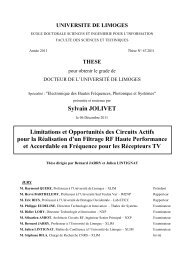Etude et conception d'un étage de mise en forme d'impulsions ultra ...
Etude et conception d'un étage de mise en forme d'impulsions ultra ...
Etude et conception d'un étage de mise en forme d'impulsions ultra ...
You also want an ePaper? Increase the reach of your titles
YUMPU automatically turns print PDFs into web optimized ePapers that Google loves.
Ne(d) =<br />
53<br />
N0eαd 1 − (ω/α)(eαd . (4.15)<br />
− 1)<br />
C<strong>et</strong>te équation perm<strong>et</strong> <strong>de</strong> définir les conditions pour l’apparition d’un claquage. En<br />
eff<strong>et</strong> si le critère suivant est atteint :<br />
ω<br />
α (eαd − 1) = 1, (4.16)<br />
alors le nombre d’électrons <strong>de</strong> l’avalanche Ne(d) t<strong>en</strong>d vers l’infini. Dans ces condi-<br />
tions, il se produit une décharge autonome : le claquage. L’égalité 4.16 est appelée critère<br />
<strong>de</strong> Towns<strong>en</strong>d [47].<br />
4.2.3 Loi <strong>de</strong> Pasch<strong>en</strong><br />
gaz :<br />
Les rapports α p <strong>et</strong> ω p sont uniquem<strong>en</strong>t <strong>de</strong>s fonctions <strong>de</strong> E p<br />
Le critère <strong>de</strong> Towns<strong>en</strong>d s’écrit alors sous la <strong>forme</strong> suivante<br />
α<br />
p<br />
ω<br />
p<br />
[48] ou p est la pression du<br />
= f (E ); (4.17)<br />
p<br />
= F(E ). (4.18)<br />
p<br />
F( E p )<br />
f ( E <br />
· e<br />
p ) f ( E p )pd <br />
− 1 = 1. (4.19)<br />
Si U est la différ<strong>en</strong>ce <strong>de</strong> pot<strong>en</strong>tiel <strong>en</strong>tre les électro<strong>de</strong>s, le champ électrique uni<strong>forme</strong><br />
s’écrit E = U/d. En remplaçant E par son expression dans le critère <strong>de</strong> Towns<strong>en</strong>d 4.21<br />
<strong>et</strong> <strong>en</strong> isolant U, nous obt<strong>en</strong>ons une fonction unique liant la t<strong>en</strong>sion <strong>de</strong> claquage (Uc) <strong>et</strong> le<br />
produit pd pour un gaz <strong>et</strong> un matériau d’électro<strong>de</strong> donné. C<strong>et</strong>te relation est appelée loi<br />
<strong>de</strong> Pasch<strong>en</strong> [49].<br />
La relation 4.17 peut être approximée par

















